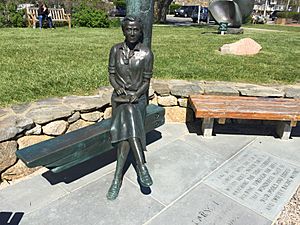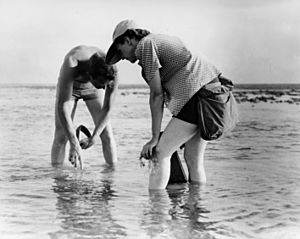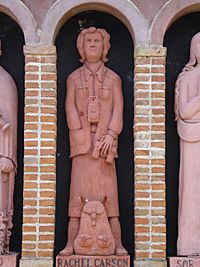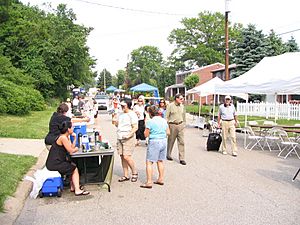Rachel Carson facts for kids
Quick facts for kids
Rachel Louise Carson
|
|
|---|---|

Carson in 1943
|
|
| Born | May 27, 1907 Springdale, Pennsylvania, U.S. |
| Died | April 14, 1964 (aged 56) Silver Spring, Maryland, U.S. |
| Occupation | Marine biologist, author and environmentalist |
| Alma mater | Chatham University (BA) Johns Hopkins University (MS) |
| Period | 1937–1964 |
| Genre | Nature writing |
| Subject | Marine biology, ecology, pesticides |
| Notable works | Under the Sea Wind (1941) The Sea Around Us (1951) The Edge of the Sea (1955) Silent Spring (1962) |
Rachel Louise Carson (born May 27, 1907 – died April 14, 1964) was an American marine biologist, a talented writer, and a conservationist. Her most famous book, Silent Spring (published in 1962), and her other writings helped start the worldwide environmental movement. She taught people to care about nature and protect our planet.
Contents
Early Life and Education
Rachel Carson was born on May 27, 1907, in Springdale, Pennsylvania. She grew up on her family's farm near Pittsburgh, which was about 65 acres (26 hectares) big. From a young age, Rachel loved to read and was a very good writer. She also spent a lot of time exploring the nature around her farm.
Rachel went to a small school in Springdale until tenth grade. She finished high school in Parnassus, Pennsylvania, graduating at the top of her class in 1925.
She then went to the Pennsylvania College for Women (now called Chatham University). Rachel started by studying English, but in 1928, she changed her major to biology. She also kept writing for the school's newspaper. After graduating with high honors in 1929, she continued her studies in zoology (the study of animals) and genetics at Johns Hopkins University.
To pay for her studies, Rachel worked in a lab. She earned her master's degree in zoology in 1932. She wanted to get a doctorate, but in 1934, she had to leave Johns Hopkins. She needed to find a full-time teaching job to help her family. Her father passed away suddenly in 1935, which made money problems even worse, especially during the Great Depression when jobs were hard to find.
Rachel Carson's Career
Working as a Biologist
Rachel's college mentor helped her get a part-time job with the U.S. Bureau of Fisheries. Here, she wrote for a radio show called Romance Under the Waters. This seven-minute program aired once a week for a year. It was all about aquatic life, especially fish. The goal was to make people more interested in fish and what the Bureau of Fisheries did. Rachel was very good at this job, even though others before her had struggled. She also started writing articles about marine life in the Chesapeake Bay for local newspapers and magazines.
Her boss was very impressed with her work. He asked her to write the introduction for a public brochure about the fisheries bureau. He also encouraged her to apply for the first full-time job that opened up. Rachel scored higher than all other applicants on the civil service exam. In 1936, she became only the second woman to be hired by the Bureau of Fisheries for a full-time, professional position as a junior aquatic biologist. Rachel worked for 15 years with the U.S. Bureau of Fisheries and later the United States Fish and Wildlife Service.
Becoming a Famous Author
In 1951, Rachel published her bestselling book, The Sea Around Us. This book was so successful that it allowed her to become a full-time nature writer. The Sea Around Us stayed on The New York Times Best Seller list for 86 weeks! It also won the 1952 National Book Award for Nonfiction and the John Burroughs Medal. Because of this book, Rachel received two special honorary doctorates. A documentary film was also made based on her book.
People recognized Rachel as a truly gifted writer. Her next book, The Edge of the Sea, and a new version of her first book, Under the Sea Wind, also became bestsellers. Together, these three books explored all parts of ocean life, from the shores to the surface and the deep sea.
In the late 1950s, Rachel became very concerned about conservation and the environmental problems caused by new chemicals called pesticides. At first, she didn't want to write about it. But when no one else would speak up about the dangers of pesticides, she decided to. She studied the problem deeply and then wrote Silent Spring, which was published in 1962.
Silent Spring is Rachel Carson's most important book. It clearly described the harmful effects of pesticides on the environment and on living things. Many people believe this book helped start the modern environmental movement. In 1994, a new edition of Silent Spring was published with an introduction written by Vice President Al Gore.
Rachel Carson's Close Friendship
Rachel Carson met Dorothy M. Freeman in the summer of 1953 on Southport Island, Maine. Dorothy wrote to Rachel to welcome her to the area when she heard the famous author was going to be her neighbor. This was the start of a very special friendship that lasted for the rest of Rachel's life.
Their friendship grew mostly through letters and during summers they spent together in Maine. Over 12 years, they wrote about 900 letters to each other. Many of these letters were later published in a book called Always, Rachel in 1995.
Rachel Carson's Death
Rachel Carson became ill with a respiratory virus in January 1964. She had been weakened by breast cancer and its treatments. Her health got worse, and in February, doctors found she had severe anemia from her radiation treatments. In March, they discovered the cancer had spread to her liver. Rachel died from a heart attack on April 14, 1964, at her home in Silver Spring, Maryland.
Her body was cremated. Some of her ashes were buried next to her mother in Parklawn Memorial Gardens, Rockville, Maryland. The rest were scattered along the coast of Squirrel Island, Maine, near the Sheepscot River in Maine.
Honors and Legacy

Rachel Carson's life and work have been widely celebrated since her death. Many places and awards are named after her:
- In 2016, the University of California, Santa Cruz, named one of its colleges Rachel Carson College. It was the first college at the university to be named after a woman.
- The Rachel Carson Center for Environment and Society was founded in Munich, Germany, in 2009.
- Her birthplace and childhood home in Springdale, Pennsylvania, is now called the Rachel Carson Homestead. It became a National Register of Historic Places site. A group called the Rachel Carson Homestead Association was created in 1975 to take care of it.
- Her home in Colesville, Maryland, where she wrote Silent Spring, became a National Historic Landmark in 1991.
- Near Pittsburgh, a 35.7-mile (57.5 km) hiking trail, called the Rachel Carson Trail, was named after her in 1975.
- A bridge in Pittsburgh was also renamed the Rachel Carson Bridge in her honor.
- The Pennsylvania Department of Environmental Protection State Office Building in Harrisburg is named after her.
- Many schools across the United States are named in her honor, including elementary schools, middle schools, and a high school.
- Two research ships in the United States have been named R/V Rachel Carson.
- Several conservation areas have also been named for Rachel Carson.

Rachel Carson is also the namesake for many awards given by groups that support good causes, education, and research:
- The Rachel Carson Prize, started in Norway in 1991, is given to women who have helped protect the environment.
- The American Society for Environmental History has given the Rachel Carson Prize for Best Dissertation (a long research paper for a degree) since 1993.
- Since 1998, the Society for Social Studies of Science has given an annual Rachel Carson Book Prize for important books about science and technology.
- The Sierra Club, a large environmental organization, and its foundation recognize donors who have included the club in their plans as the Rachel Carson Society.
Interesting Facts About Rachel Carson
- Rachel loved to read and started writing stories, often about animals, when she was eight years old. Her first story was published when she was ten.
- She especially enjoyed St. Nicholas Magazine, the works of Beatrix Potter, and the novels of Gene Stratton-Porter. As a teenager, she liked Herman Melville, Joseph Conrad, and Robert Louis Stevenson.
- She particularly loved reading about the natural world, especially the ocean.
- The documentary based on her book The Sea Around Us won the 1953 Academy Award for Best Documentary Feature.
- In 2012, her book Silent Spring was recognized as a National Historic Chemical Landmark. This was for its important role in starting the modern environmental movement.
- After her older sister died, Rachel took care of her two nieces.
- On June 9, 1980, Rachel Carson was given the Presidential Medal of Freedom. This is the highest award a civilian can receive in the United States.
- A 17-cent Great Americans series postage stamp was issued in her honor in 1981.
- In 1973, Rachel Carson was added to the National Women's Hall of Fame.
- Google created a Google Doodle for Rachel Carson's 107th birthday on May 27, 2014.
- The Rachel Carson sculpture in Woods Hole, Massachusetts, was shown to the public on July 14, 2013.
- Rachel Carson's manuscripts (her original writings) and papers were given to Yale University.
Famous Quotes by Rachel Carson
- "The aim of science is to discover and illuminate truth."
- "I like to define biology as the history of the earth and all its life — past, present, and future."
- "One way to open your eyes is to ask yourself, 'What if I had never seen this before? What if I knew I would never see it again?'"
- "It is not half so important to know as to feel."
- "Those who contemplate the beauty of the earth find reserves of strength that will endure as long as life lasts."
- "As human beings, we are part of the whole stream of life."
See also
 In Spanish: Rachel Carson para niños
In Spanish: Rachel Carson para niños





